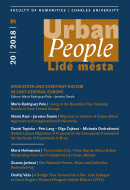A Bridge That Turned Into a Pier
Late Epilogue to Karel Prager’s Vision of Prague’s Košíře District (1975)
DOI:
https://doi.org/10.14712/12128112.3291Keywords:
architecture, urbanism, bridge, megastructure, superstructure, Situationist International, Prager, Friedman, MakiAbstract
Karel Prager’s project of the experimental housing development in Košíře (1975) was doomed to be an ultimate failure from the beginning. As a specific variation of Yona Friedman’s vision of the “city above the city”, it was supposed to hover above the town, exploiting inaccessible or built‑up terrain, as well as avoiding a costly and painful redevelopment. It promised to be just a small sample of a universal solution for overpopulated cities, as well as a universal construction set for any unforeseen requirements of the future populations. For these purposes, the simple frame utilised the bridge‑system, and also relied on the logic of the labyrinth. Yet in doing so, however unintentionally, it both turned the existing city into a second‑rate underworld and imposed on its inhabitants a most determinative system of limited variations, trading the burden of architectural responsibility for the apparent freedom of combinatorics. The essay analyses both the key structural elements of the superstructure – the bridge, the labyrinth, the environmental aspect – and the logic of the megastructural movement which presents a proper context for Prager’s vision.
Downloads
Published
How to Cite
Issue
Section
License

This work is licensed under a Creative Commons Attribution-NonCommercial-NoDerivatives 4.0 International License.



